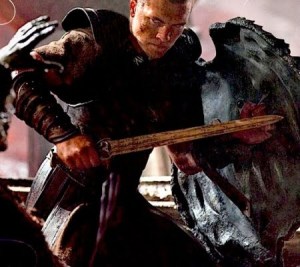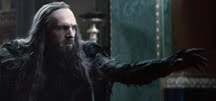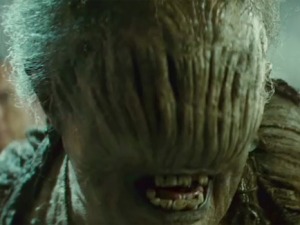 I saw the remake of Clash of the Titans this weekend, in 2D as Roger Ebert recommended, and I must say I really don’t understand where the critics were coming from. It got a measly 30% approval rating on Rotten Tomatoes and some of the reviewers even seemed to take personal umbrage. Ebert was one of the few to give it a (qualified) positive review.
I saw the remake of Clash of the Titans this weekend, in 2D as Roger Ebert recommended, and I must say I really don’t understand where the critics were coming from. It got a measly 30% approval rating on Rotten Tomatoes and some of the reviewers even seemed to take personal umbrage. Ebert was one of the few to give it a (qualified) positive review.
Usually I think films in this genre need a couple of robots and a human making wisecracks in the lower right-hand corner of the screen to make them bearable, but Clash had a comprehensible plot that was easy to follow and delivered the action and special effects goods.
The screenplay is based on the 1981 original and involves battles between gods and men, demigods, sacrifices, big monsters, nasty gorgons, pegasuses (pegasi?) and all the other mythical elements you’re familiar with. And, like the original, it’s got lots of stars.
As Perseus, the demigod who finds himself caught in the middle of the war between the gods and humankind, Sam Worthington is all stoicism and gnashing teeth. Some people complain that he doesn’t give very much as an actor, but it didn’t bother me. Liam Neeson projects just the right amount of godliness as Zeus, but it’s Ralph Fiennes who really steals the show as Hades, god of the underworld.
 His Hades could have been hammy or campy, but Fiennes brings a kind of Richard III aspect to the performance. He speaks in a malevolently hoarse growl and moves with a sort of sideways slink. And thanks to the quite good digital effects, he makes his dramatic entrances wreathed in black smoke and flame, which looks really cool.Gemma Arterton as Io, who helps Perseus on his quest, and Alexa Davalos, as the doomed Andromeda, are both attractive and have a nice screen presence. Pete Postlethwaite, Danny Huston, Jason Flemyng and Jane March also appear, but some literally have blink-and-you’ll-miss-them screentime.
His Hades could have been hammy or campy, but Fiennes brings a kind of Richard III aspect to the performance. He speaks in a malevolently hoarse growl and moves with a sort of sideways slink. And thanks to the quite good digital effects, he makes his dramatic entrances wreathed in black smoke and flame, which looks really cool.Gemma Arterton as Io, who helps Perseus on his quest, and Alexa Davalos, as the doomed Andromeda, are both attractive and have a nice screen presence. Pete Postlethwaite, Danny Huston, Jason Flemyng and Jane March also appear, but some literally have blink-and-you’ll-miss-them screentime.
 I’m certainly not going to demean the legendary Ray Harryhausen or his work on the original, but the modern digital effects amp up the action significantly. Medusa has not just snakes for hair but also a snake’s body, and she slithers around real good as she transforms selected soldiers into statues. The three witches who tell Perseus how he can defeat the Kraken (one pictured here) are eyeless, shriveled creatures who share a single detached eye that they hold in the palms of their hands to see, which reminded me of The Pale One in Guillermo Del Toro’s masterpiece Pan’s Labyrinth. And there are giant sand scorpions reminiscent of the alien bugs in Paul Verhoeven’s rollicking Starship Troopers, which as far as I’m concerned is another plus.
I’m certainly not going to demean the legendary Ray Harryhausen or his work on the original, but the modern digital effects amp up the action significantly. Medusa has not just snakes for hair but also a snake’s body, and she slithers around real good as she transforms selected soldiers into statues. The three witches who tell Perseus how he can defeat the Kraken (one pictured here) are eyeless, shriveled creatures who share a single detached eye that they hold in the palms of their hands to see, which reminded me of The Pale One in Guillermo Del Toro’s masterpiece Pan’s Labyrinth. And there are giant sand scorpions reminiscent of the alien bugs in Paul Verhoeven’s rollicking Starship Troopers, which as far as I’m concerned is another plus.
 His Hades could have been hammy or campy, but Fiennes brings a kind of Richard III aspect to the performance. He speaks in a malevolently hoarse growl and moves with a sort of sideways slink. And thanks to the quite good digital effects, he makes his dramatic entrances wreathed in black smoke and flame, which looks really cool.Gemma Arterton as Io, who helps Perseus on his quest, and Alexa Davalos, as the doomed Andromeda, are both attractive and have a nice screen presence. Pete Postlethwaite, Danny Huston, Jason Flemyng and Jane March also appear, but some literally have blink-and-you’ll-miss-them screentime.
His Hades could have been hammy or campy, but Fiennes brings a kind of Richard III aspect to the performance. He speaks in a malevolently hoarse growl and moves with a sort of sideways slink. And thanks to the quite good digital effects, he makes his dramatic entrances wreathed in black smoke and flame, which looks really cool.Gemma Arterton as Io, who helps Perseus on his quest, and Alexa Davalos, as the doomed Andromeda, are both attractive and have a nice screen presence. Pete Postlethwaite, Danny Huston, Jason Flemyng and Jane March also appear, but some literally have blink-and-you’ll-miss-them screentime.
 I’m certainly not going to demean the legendary Ray Harryhausen or his work on the original, but the modern digital effects amp up the action significantly. Medusa has not just snakes for hair but also a snake’s body, and she slithers around real good as she transforms selected soldiers into statues. The three witches who tell Perseus how he can defeat the Kraken (one pictured here) are eyeless, shriveled creatures who share a single detached eye that they hold in the palms of their hands to see, which reminded me of The Pale One in Guillermo Del Toro’s masterpiece Pan’s Labyrinth. And there are giant sand scorpions reminiscent of the alien bugs in Paul Verhoeven’s rollicking Starship Troopers, which as far as I’m concerned is another plus.
I’m certainly not going to demean the legendary Ray Harryhausen or his work on the original, but the modern digital effects amp up the action significantly. Medusa has not just snakes for hair but also a snake’s body, and she slithers around real good as she transforms selected soldiers into statues. The three witches who tell Perseus how he can defeat the Kraken (one pictured here) are eyeless, shriveled creatures who share a single detached eye that they hold in the palms of their hands to see, which reminded me of The Pale One in Guillermo Del Toro’s masterpiece Pan’s Labyrinth. And there are giant sand scorpions reminiscent of the alien bugs in Paul Verhoeven’s rollicking Starship Troopers, which as far as I’m concerned is another plus.
There are also surprising touches of offbeat humor. In an almost throwaway scene, Perseus holds up that goofy mechanical owl from the first film and asks, “What’s this?” The leader of the guard looks at it and gruffly says, “Leave it.” Also, as one of the soldiers is being killed by a scorpion, I swear he screams, “Wait! Wait! Aaagghhh!” And when Medusa can’t turn a Djinn into stone (because he’s not made of flesh and blood), she gets a hurt expression on her face that’s hilarious.The score, by Ramin Djawadi (Iron Man) is lush and appropriately bombastic, keeping the action rolling along and even providing some amusing cues of its own. During the scorpion attack, as one of them stabs a soldier two times with his deadly tail, Djawadi punctuates the puncturing with two sharp synchronized notes.I can see how a bad 3D conversionmight’ve made it an ordeal to watch. There’s always a lot of activity onscreen, which probably results in some serious blurring, and the glasses darken images about 20 percent. A film that wasn’t originally made for the format wouldn’t compensate for such details. But in 2D it looked just fine.To summarize, is it a timeless masterpiece? Well, no, but it’s a fun, fast-paced, 100 minutes that fans of the Harryhausen classics of the ’60s will especially enjoy. And it certainly didn’t deserve all of the critical drubbing it got.
